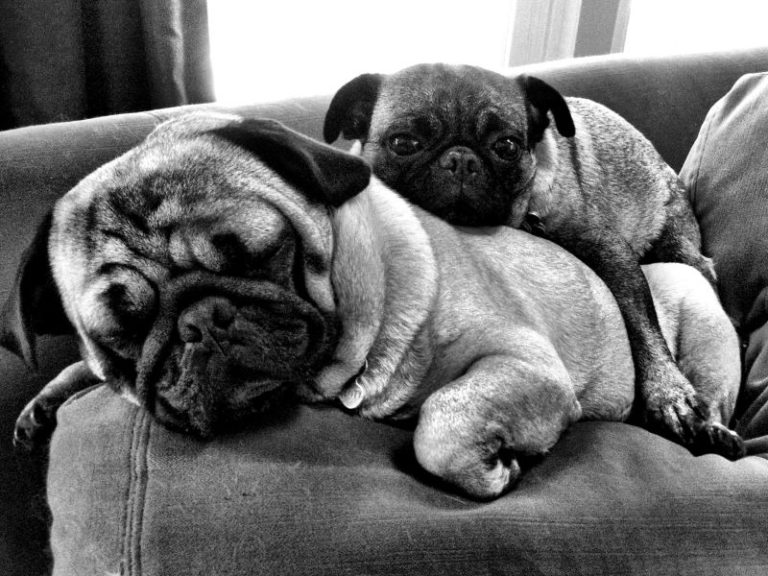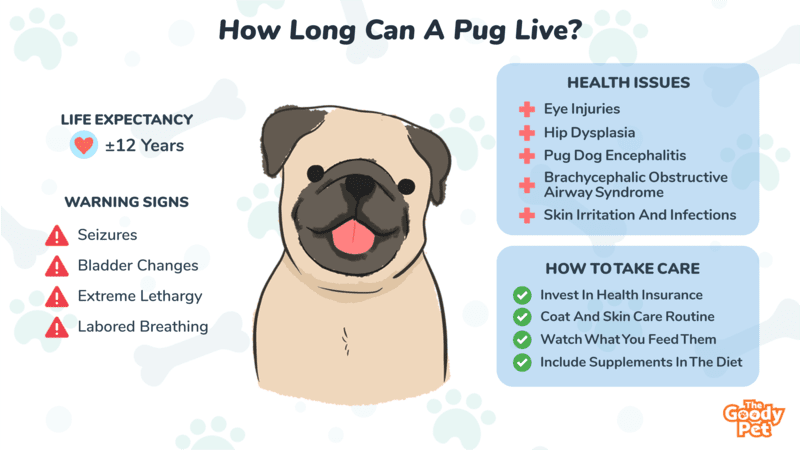Pugs are strikingly cute, with their smooshed up little faces, wrinkly foreheads and large, beady eyes. However, what many of us do not realize is that there is a huge price to pay for this aesthetic. And the entire bill is on the pug itself.
Pugs can live for 12 to 15 years. However, the majority of them do not make it past their 11th birthday. This is because they are generally very sickly dogs. Most of the illnesses that plague their lives are associated with their brachycephalic facial structure. This could lead to all sorts of complications from injuries and difficulty controlling temperature to obstructed breathing.
In addition to the complications that come with their faces, pugs suffer a host of other systemic health issues. In the sections to come, we will take a closer look at some of these and how you can best take care of your pooch for a longer and more comfortable life. Let’s get right to it.
What Health Problems Do Pugs Have?

Health problems in pugs could either be due to their brachycephaly or other systemic issues.
The brachycephaly, or short face, is marked by a short snout and flattened brow ridges. This may make the pug super cute but it has several consequences. Here are 4 of the most important of these.
Brachycephalic Obstructive Airway Syndrome
This results in difficulties breathing and could result in respiratory distress if the dog is injured or otherwise stressed.
Eye Injuries
Pugs have very large eyes that are exposed due to the head shape. If they get into contact with something face first, injuries are inevitable.
Reverse Sneezing
This is as a result of the pharyngeal gag reflex and can be really irritating for the dog.
In addition to these 4 complications, pugs may also suffer from other health issues unrelated to their faces. These include:
Obesity
Pugs love to eat. They are also not the most active of dogs. This is a problematic combination of traits that could result in overeating and eventual obesity.
Hip Dysplasia
Pugs are the second most commonly affected dog breed by hip dysplasia. The abnormal formation of the joint socket is associated with issues including unusual gait, pain, and even arthritis.
Skin Irritation And Infections
This is often associated with the skin folds that pugs are known and loved for. They provide the perfect spot for everything from germs to pest to hide. They are therefore the focus of several infections and irritation if proper grooming is not a part of the routine.
Pug Dog Encephalitis
This is an unusual and life-threatening condition that affected pugs inherit from their parents. It causes inflammation and eventual death of brain tissues. Unfortunately, there is no cure.
Is It Bad To Own A Pug?

For a long time now, there has been a continuing debate on whether or not it is ethical to either own or breed purebred pugs. This is because their genetics and anatomy put them at risk of so many diseases and such discomfort throughout their lives. While it is not illegal to breed a pug, it is frowned upon by many regulating authorities all over the world. Ownership on the other hand is a completely different story.
Let us look at it in one of two ways. If there is a pug already in existence in a shelter that needs a loving home, it would be ok to own it. After all, they are already here and need a good home so why not. You just have to be prepared for all the effort it takes to adopt, love and raise these frail fur babies.
However, if you want one for the aesthetics and plan to order from a breeder, you are probably not making the best decision. This is because you would be creating a market for harmful breeding that does no favors to the little doggies.
If you really must have a pug, we suggest that you go for a mixed breed like a retro pug. These are mixed with long snout breeds to create healthier versions of the little, wrinkled beauties. With retro pugs in particular, you could actually increase the dog’s life expectancy to up to 16 years. The best part is that they do not have to suffer many, if any at all, of the complications of brachycephaly.
How To Take Care Of A Pug?
Pugs are relatively low maintenance dogs when it comes to things like grooming, training, and entertainment. However, their health issues may require you to put in a little more effort. To make your life easier, here are a few tips you could employ to give your pooch the best possible life in your home.
Watch What You Feed Them
Pugs are sickly and prone to obesity. As a result, diet is something you cannot afford to take lightly. We recommend the Pet Plate meal delivery service. They offer a variety of high quality and chemical free that are freeze preserved to keep them fresh for your doggy.
Include Supplements In The Diet
In addition to the balanced diet, a few supplements will go a long way towards helping the doggy. Bone and joint supplements with compounds like chondroitin and glucosamine are especially useful. This is because pugs suffer from a variety of skeletal issues including joint dysplasia and hemivertebrae.
The fight against joint problems should start when your dogs turn adult. One of the best ways to deal with this is to add glucosamine supplements to their meals. You could also simply use them as dog treats during your training or snack time. Read about some of the best glucosamine supplements that we would strongly recommend to start consuming now in order to fight off hip dysplasia in this article right here.
Establish A Coat And Skin Care Routine
It is important that you take extra special care of your pug’s skin. This will not only prevent irritation in the folds but also minimize the impact of things like flea and mite infestations that they happen to be prone to.
Invest In Health Insurance
Taking care of your pug’s health can be costly. This is why we recommend you invest in good insurance or a financial support plan for those inevitable rainy days.
Eusoh is easily one of your best options as a pug parent. It is not a pet insurance in the traditional sense. Instead, it uses more of a community support model to help dog parents cover everything from emergency care to routine vet visits. You just have to invest about $40 a month and you will be eligible for the support.
Can Pugs Exercise?
Pugs have a very laid back temperament. This spills over to their activity level. While many dogs that size are just firecrackers bursting with energy, pugs just like to lay around and observe their environment.
This may be convenient for busy dog parents. However, it is not a great idea to encourage this inactivity. This is because pugs are very prone to obesity and heart disease. As a result, it is best to invest time in keeping them active for their own sake.
We would recommend about 20 to 30 minutes of exercise every day for a pug. It could be anything from a walk to playing in the backyard together. This helps keep them active and healthy while stimulating them both mentally and physically.
You could also make things fun for them by organizing playdates. This makes them more interested in playing. It could be a visit to a fellow dog parent’s home or even a simple trip to the dog park.
However, it is important to know that it is possible to walk a pug too much. This is because of a variety of reasons from their lack of athletic prowess to health issues like hip dysplasia. Their brachycephaly also makes breathing and heat regulation more difficult for pugs when they exercise for long. Therefore, you will have to pay attention to their cues. If they seem exhausted or in pain, it is ok to take a break or find other ways to keep them active.
What Do Pugs Usually Die From?
Issues associated with brachycephaly, though uncomfortable, are rarely life threatening. Pugs die from other health issues, the most common being pug dog encephalitis. As earlier mentioned in the health issue section, pug dog encephalitis is an inherited and non-curable disease. It slowly eats away at your dog’s brain eventually resulting in death.
Here are a few ways to know if your pug is dying whether from the encephalitis or other health problems.
Extreme Lethargy
Extreme lethargy is one of the most important symptoms of a dying dog, whatever the cause is. You may notice that they are reluctant to even do bare minimum activities like short walks. And when they do, they take very long to recover their energy.
Behavior Changes
This could affect their mood in which case they may get more aggressive or more passive than normal. It also affects their appetite with most affected pugs eating very little if anything at all.
Seizures
Seizures are associated with pug dog encephalitis and can occur at any stage of the disease. If the seizures get longer, more powerful, or shorter in intervals, it could be a sign that the condition is progressing towards the final fatal stages.
Labored Breathing
This could be due to the encephalitis when respiratory control centers are affected. It could also be as a result of exhaustion and increased fatigability. Finally, difficulty breathing could be a sign that your dog is dying from chronic respiratory distress.
Bladder Changes
A lot of pugs lose continence as they get older or when they are dying from health issues. If they seem to have lost power of bowel and bladder control without other psychological causes, it is an ominous sign.
Related Questions
What Is The Oldest Living Pug? Pugs have a short life expectancy for small dogs with an average of 11 years. However, it is possible for them to live up to 15 and even more. A fantastic example is that of King Tug the Pug from America who lived up to the ripe old dog age of 18 years.
Are Girl Or Boy Pugs Better? Pugs are generally very calm and affectionate. However, boy pugs tend to be more loving and friendlier than female pugs. They are therefore the better option if you want an affectionate lap dog relationship with your pooch. Females are also pretty awesome despite being more aggressive and aloof. All you have to do is show them consistent affection and care and they will grow to trust you.
Do All Pugs Have Down Syndrome? Pugs do not suffer from Down Syndrome. This is purely a human condition. This is a common misconception as a result of their brachycephaly which is also present in humans with the genetic condition. However, pugs have been known to suffer from other chromosomal abnormalities similar to Down Syndrome in humans.





